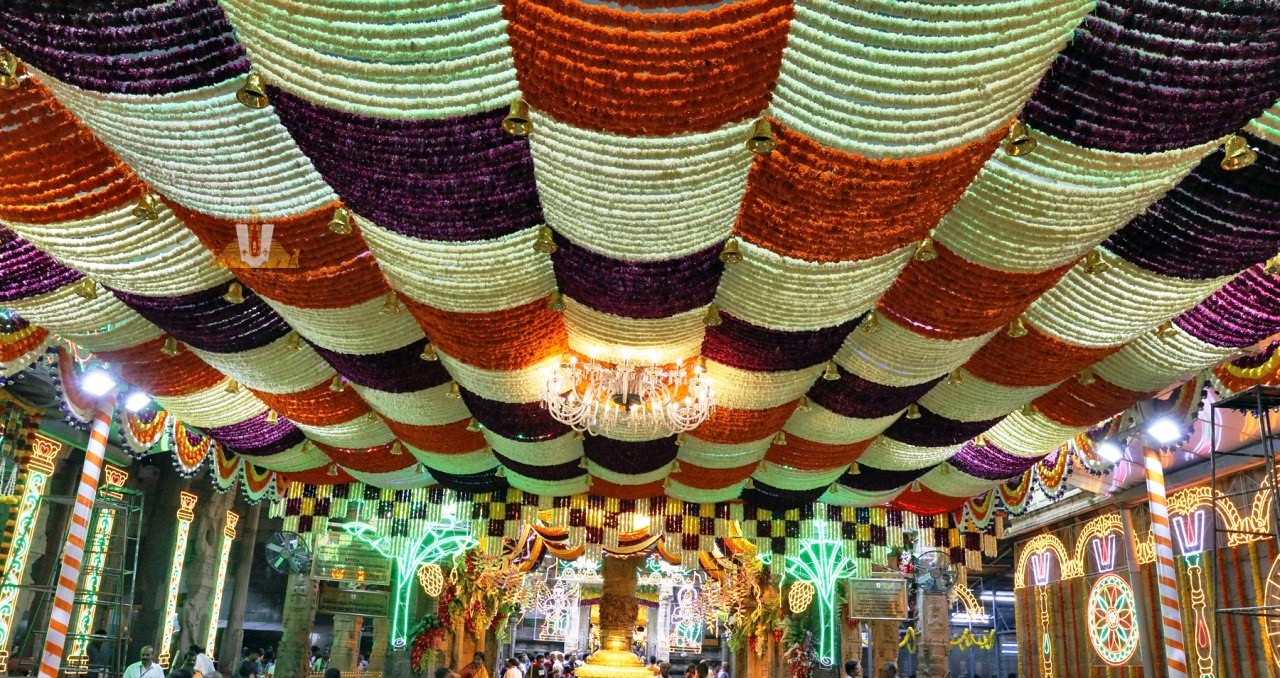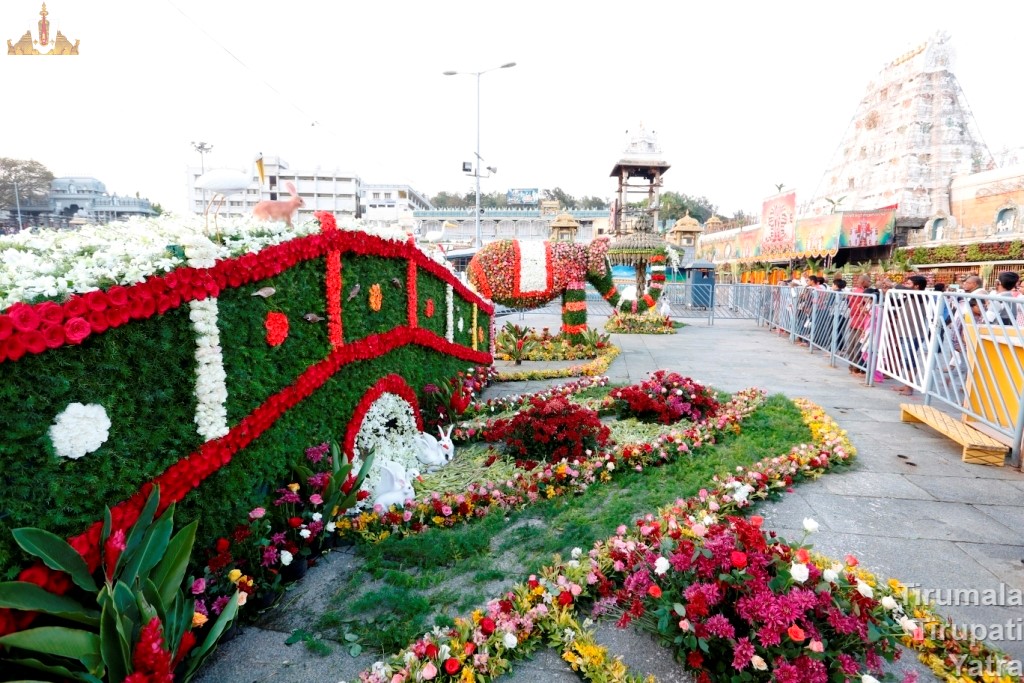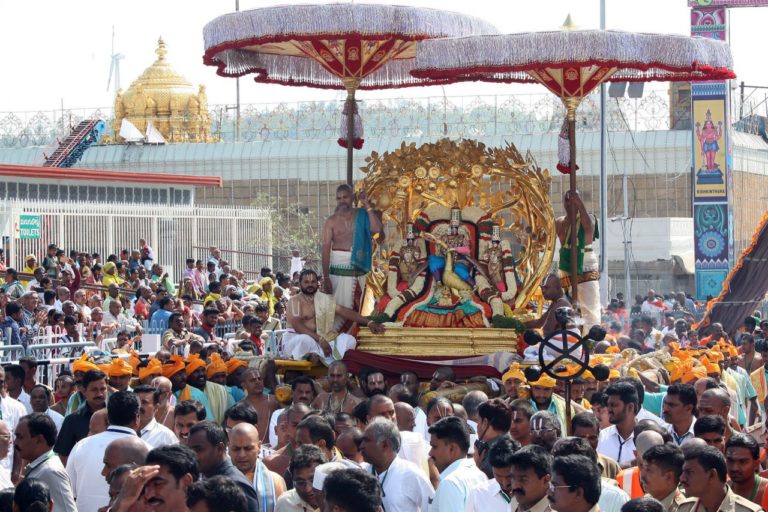Table of Contents
ToggleFestivals in Tirumala Temple
The Tirumala temple is famous from earliest times for the festivals conducted on the hill. Those festivals continue with increasing popularity even up to the present day.
In ancient days under royal patronage, the temple had received gifts and endowments primarily for the worship of the Lord and secondarily for augmenting the grandeur and attraction of the temple and increasing its popularity employing elaborate festivals and profuse food offerings.
Even the construction of spacious and artistic mandapams and imposing prakarams and gopurams were intended only for this purpose.
Festival - Types
The festivals in the temples may be classified into two broad divisions, namely, the basic festivals connected with the ritual of temple worship which is enjoined by the Sastras and agamas, and auxiliary or secondary festivals according to the nature of this establishment, endowment by devotees, etc.


Basic Festivals
The basic festivals are compulsorily being enjoined by the Agamas and the Sastras to be observed at fixed times of the Calendar to coincide with some astronomical data the omission of which would be considered to be most inauspicious.
In fact, in many temples, restitution of these festivals once suspended would call for special Suddhi rites. The most popular festival of Tirumala which is known as ‘Brahmotsavam’ belongs to this category of basic festivals.
Auxiliary types of festivals
The secondary or auxiliary types of festivals are individual festivals connected with some incident in the traditional legends about the particular idol in worship in that temple, or they may be connected with some divine incidents about the avatara or incarnation of God, etc.
Such a festival at Tirumala would be the ‘Tirupallieluchchi’ which is the Dhanurmasa festival. Similar would be the festivals that are conducted on the days that coincide with the Nakshatra or birth asterisms of many of the deities.
These subsidiary festivals generally would have been instituted by wealthy patrons or by royalty to seek divine grace or to obtain religious merit. Endowments were usually made by them with specific provisos that the proceeds of the endowments should be used for conducting the festivals on the days specified by them.
These days generally would be the nakshatra days of the person making the endowment or that of his religious guru or King, or any other relation or some friend.
In Tirumala temple, the above types of festivals are also celebrated.
The Brahmotsava festival
The Brahmotsava festival at Tirumala is the most popular festival drawing huge crowds. This is a basic festival enjoined by the Sastras. The festival bears the name ‘Brahmotsava’ to commemorate the first Utsavam of the Lord of Tirumala which was conducted by Brahma, the Lord of Creation as per Varaha Purana. This Utsavam is conducted according to the injunctions of the Sastras.
Before 966 A.D. perhaps only one Brahmotsavam was conducted at Tirumala. In 966 A.D. the Pallava Queen Samavai who arranged for the installation of the Bhoga Srinivasa Murthy idol in the temple, made provisions to conduct two Brahmotsava festivals, one in Purattasi month and the other during the Mukkoti Dvadasi period.
Thus two Brahmotsavas were being performed from the 10th Century A.D. The same Queen also presented several jewels and ornaments including a Kiritam or crown and arranged for endowments for the conduct of the festivals with a procession for the Bhoga Srinivasa Murthy for a few days immediately preceding the main festival as well as during the main festival itself in the month of Purattasi commencing on the day of Chittirai and lasting for nine days.
In the same year, the same Queen made a further provision for another festival for the same silver idol with two processions each day for seven days before Margali Tiru Dvadasi which is the Mukkoti Dvadasi.
To meet the expenses of these, the Queen endowed certain lands to the temples and enjoined the administrators called the Stanattars to take care to see that no tax was levied on the land granted by her.

12 day festival
The Brahmotsavam was celebrated for a period of twelve days counted from the day of ankurarpana (sowing of seeds) of nine kinds of seeds in earthen vessels to the day of Vidayarru, or the day of preparations for relaxation after the exertions of the temple servants for twelve days during the festival.
Each day after the procession was over, the Utsavamurthi was taken away into the temple to a mantapa, installed there in an asthana or an assembly, and was offered the special naivedya provided for the occasion by the devotees.
Similar asthanams were also arranged by the devotees to be conducted in the mandapams built in their flower gardens, around the temple to which the Utsavamurthi was taken during the procession before returning to the temple. In fact the asthana formed a feature not only in the brahmotsavam but in other festivals also.
Vaikunta Ekadasi
Till some decades ago the temple conducted four Brahmotsava festivals in a year;
- the first in purattasi month,
- the second on the Rathasaptami day,
- the Third on the Kausika Ekadasi day in the Kartika month, and
- the fourth on Vaikunta Ekadasi or Mukkoti Ekadasi day.
The festivals are conducted for several days. The festival during the Rathasapthami period is considered to be an arsha utsava, while that on the Kausika Dvadasi day is considered to be a rakshasic one. The most important of these is the purattasi month Utsavam generally conducted in September-October.
The utsavam commences on the day when Sravana Nakshatra is prominent. At present only this festival is conducted.
Sankranti Festival
The Sankranti festival corresponds to the movement of the sun in the heavens. Of these, the Makara Sankranti and Karkataka Sankranti corresponding to the Uttarayana and Dakshinayana Punyakalas are specially observed universally.
Vishu Sankrantis corresponding to the vernal and autumnal equinoxes are less important. Still, all these occasions together with Amavasya days are considered to be very holy ones, and hence these have been observed in the temples also.
Vasantotsavam and Grishmotsavam
The Lord of the universe is conceived by man in his image and hence the Lord partakes also in man’s festivals like
- Vasantotsavam (Spring festival),
- Grishmotsavam (summer festival),
- Unjal Tirunal (swinging festival) and
- the tiruppali-odam-tirunal (the floating festival).
During the spring season or Vasanta ritu in the month of Vaikashi the Brahmotsavam of Sri Govindaraja of Tirupati is celebrated, on the 6th day of which the Vasantotsavam is celebrated with a procession of the Lord during the main streets. Nowadays, there is a function in the evening and special chandanam is distributed.
From epigraphs, we learn that a large quantity of chandanam was used for the festival in the past. Hence this distribution of sandalwood paste would appear to be an ancient custom. Since Vasantotsavam is coupled with Brahmotsavam and occurs on the 6th day of the Brahmotsavam, this utsavam also got doubled as the Brahmotsavam was increased to two in the 13th century, till the middle of the 16th century, when two more Brahmotsavam were instituted when this also got automatically increased.
A similar auxiliary Vasantotsavam was arranged for the last two days of the Kodai-tirunal during the reign of Krishnadevaraya (311-IT). Besides this auxiliary Vasantotsavam, there seems to have been celebrated another Vasantotsavam as a main festival by itself, lasting for three days in the month of Chittirai, from the day of the star Chittirai, i.e.,Chitra, which would coincide with the purnima or the full-moon day (No.105-G.T.).
During the time of Achyutaraya, a fresh Vasantotasavam was started in Saka 1460, Vilambi, by one Periya-Solai, son of an accountant in the temple at Tirumala, by instituting a fund of 3000 narpanam (No. 345-0.T.)
The preliminary rite of ankurarpanam (sowing the nine kinds of seeds) was required to be done on the day of Uttirattadi or Uttarabhadra star in the month of Panguni and the Sattumurai (the last) day was to fall on the day of Kartika or Krittika star such that the tirunal was celebrated for four days.
Since these festivals were not primary and obligatory ones, they could be increased and modified to any extent to which the devotees desired and consequently, we find variation in them.
Ratha Sapthami Festival
This is a well-known festival celebrated at sunrise on the Magha Suddha Saptami tithi. It is considered a Visesha Divasam which is generally celebrated in all Vishnu temples. It is ‘first mentioned in an inscription of the year 1564.
This is probably because no endowment was made for it till 1564 A.D. (No. 376-G.T.) In the year 1538 A.D. one Tiruvanantalvar Kuppayyan made an endowment of 700 panams from the income of which a Ratha Saptami festival was to be celebrated for Sri Govindarajaswami on the Sukla Saptami day in the month of Tai.
On this occasion, there was a Tirumanjanam and procession in Suryaprabha vahanam along with Nachchimar and Senai mudaliar.
